"Straight or Crooked"
Leonard,
I think there is a big difference between a client/connaisseur, who is able to see and therefore able to appeciate the work of any artisan: painter, stonemason, architect, or tailor and a client who would micro-manage the work of an artisan. I hope the LL is full of the former and devoid of the latter type of interested and involved client.
The Jimmy Stewart coat is a thing of beauty!
Cheers
I think there is a big difference between a client/connaisseur, who is able to see and therefore able to appeciate the work of any artisan: painter, stonemason, architect, or tailor and a client who would micro-manage the work of an artisan. I hope the LL is full of the former and devoid of the latter type of interested and involved client.
The Jimmy Stewart coat is a thing of beauty!
Cheers
Gentlemen,
I know this just seems like another good LL thread, but it dawned on me how fortunate the members of this club are. In this thread we are discussing a sartorial topic of great interest with four world class tailors! Three of them have provided illustrations to clarify the concept being discussed. I don’t know where else on the web this kind of expertise is assembled and made available to current or potential custom clothing customers.
The London Lounge is setting a standard that no other site can equal.
I hope all the members are taking good care of the artisans who are contributing to the discussion here. They certainly deserve our interest and custom for the value they are helping to create.
I extend my sincere thanks.
M Alden
I know this just seems like another good LL thread, but it dawned on me how fortunate the members of this club are. In this thread we are discussing a sartorial topic of great interest with four world class tailors! Three of them have provided illustrations to clarify the concept being discussed. I don’t know where else on the web this kind of expertise is assembled and made available to current or potential custom clothing customers.
The London Lounge is setting a standard that no other site can equal.
I hope all the members are taking good care of the artisans who are contributing to the discussion here. They certainly deserve our interest and custom for the value they are helping to create.
I extend my sincere thanks.
M Alden
-
smoothjazzone
- Posts: 279
- Joined: Wed Feb 09, 2005 4:13 pm
- Contact:
This discussion seems way too complicated. The way I have always understood these concepts are as follows:
A person will either have his shoulders curved forward (to some extent like certain coat hangers that are curved) or a bit straighter. If the tailor is able to construct a coat that matches the curvature of your shoulders, the garment will feel comfortable. The right level of curvature will vary from person to person.
Lets take the case of a person whose shoulders curve far forward (for e.g., me!), the tailor needs to cut a slightly wider back and a slightly narrower front. What is also helpful, but not necessary in this regard, is that the shoulder seam angle back towards the neck and have a shorter back neck (i.e., the distance between the back center seam and the point where the shoulder seam meets the neck). For an individual with a straighter shoulder, the angle can be a lot smaller. Alternatively, some (e.g., A&S) cut the coat with the shoulder seam much further back on the shoulder such that the shoulder seams are a little straigher than is otherwise the case.
My experience is that for ME (my shoulders are a lot more forward than most), a high armhole, a "crooked" shoulder, a shoulder seam thats further back and a tight collar allow for the greatest amount of movement while helping keep the garment comfortably on me at all times.
The problems arise when tailors make either a straigher or a "crooked" coat almost out of habit without regard to your unique physique -- the result as Len has pointed out is a terrible fitting coat even though it may look fine. My first garment from a certain highly reputable New York tailor is one such garment. Most everyone that has seen me wearing it seems to think its a very well fitting suit. Reality is that it is a most uncomfortable garment to wear maily because its cut quite straight. I constantly feel that my shoulders are being constricted in some way.
One culprit in these situations is as Alden pointed out customers standing erect with their shoulders pulled back in some sort of military posture. Even the best of tailors will be tempted to cut a straigher coat than is necessary. Hence, the importance of assuming a very natural posture during fittings. Even a straight coat, depending on the fabric and the sewing adapt more (not perfectly) to your body over time.
So from my point of view you dont need a straight or crooked coat, you just need the coat that will fit you well. Hope this is somewhat accurate (the tailors on this forums can comment) and helpful.
A person will either have his shoulders curved forward (to some extent like certain coat hangers that are curved) or a bit straighter. If the tailor is able to construct a coat that matches the curvature of your shoulders, the garment will feel comfortable. The right level of curvature will vary from person to person.
Lets take the case of a person whose shoulders curve far forward (for e.g., me!), the tailor needs to cut a slightly wider back and a slightly narrower front. What is also helpful, but not necessary in this regard, is that the shoulder seam angle back towards the neck and have a shorter back neck (i.e., the distance between the back center seam and the point where the shoulder seam meets the neck). For an individual with a straighter shoulder, the angle can be a lot smaller. Alternatively, some (e.g., A&S) cut the coat with the shoulder seam much further back on the shoulder such that the shoulder seams are a little straigher than is otherwise the case.
My experience is that for ME (my shoulders are a lot more forward than most), a high armhole, a "crooked" shoulder, a shoulder seam thats further back and a tight collar allow for the greatest amount of movement while helping keep the garment comfortably on me at all times.
The problems arise when tailors make either a straigher or a "crooked" coat almost out of habit without regard to your unique physique -- the result as Len has pointed out is a terrible fitting coat even though it may look fine. My first garment from a certain highly reputable New York tailor is one such garment. Most everyone that has seen me wearing it seems to think its a very well fitting suit. Reality is that it is a most uncomfortable garment to wear maily because its cut quite straight. I constantly feel that my shoulders are being constricted in some way.
One culprit in these situations is as Alden pointed out customers standing erect with their shoulders pulled back in some sort of military posture. Even the best of tailors will be tempted to cut a straigher coat than is necessary. Hence, the importance of assuming a very natural posture during fittings. Even a straight coat, depending on the fabric and the sewing adapt more (not perfectly) to your body over time.
So from my point of view you dont need a straight or crooked coat, you just need the coat that will fit you well. Hope this is somewhat accurate (the tailors on this forums can comment) and helpful.
-
andreyb
Michael, don't underestimate the Lounge!alden wrote:Gentlemen,
I know this just seems like another good LL thread, but it dawned on me how fortunate the members of this club are. In this thread we are discussing a sartorial topic of great interest with four world class tailors!
We have not four, but six great tailors in this thread: Thomas Mahon, Leonard Logsdail, Chris Despos, Edwin DeBoise, Des Merrion, and Martin Stall.
Gentlemen, thank you for your participation!
Andrey
Andrey
Goodness gracious, you are right.
My thanks to all of them.
Michael
Goodness gracious, you are right.
My thanks to all of them.
Michael
-
schneidergott
- Posts: 149
- Joined: Mon Jul 09, 2007 8:13 pm
- Location: Castle Douglas, Scotland
Hello, everyone!
The good thing about beeing an employed tailor is the advantage of having much more time to spend than the other master tailors, who did those excellent explanations on the subject before me.
The following illustrations might explain what was ment with "balance":
There are 3 basic postures: Normal, erect and stooping, each one with further variations.
While the normal posture would not create much problems in terms of balance, the other two would.
Each person can easily check his natural posture in the mirror and by trying an "unnatural" one. The "unnatural" posture becomes unpleasant after a while with the muscles tensioning and aching.
The broken lines show the original pattern, manipulations and changes are marked with arrows!
First posture: Erect
This shows the manipulation of the pattern for a slightly erect posture, just adding a little length in the frontpart:

This is the one for a very erect person with narrow back and strong chest:

Next is the slightly stooping posture, just adding some length to the back:

And finally the one for a very stooping posture:

I hope the images show the effects of the changes in a way that even those people, who are not dealing with such matters, might have an understanding.
If so, again the request: Stand as natural as possible. You can trust your tailor, he knows what is best for your posture.
By standing naturally you will avoid a lot work and anger(most likely coming along with the unholiest wishes for the customer).
I hope, by adding this comment, I could avoid at least a bit of both!
SG
The good thing about beeing an employed tailor is the advantage of having much more time to spend than the other master tailors, who did those excellent explanations on the subject before me.
The following illustrations might explain what was ment with "balance":
There are 3 basic postures: Normal, erect and stooping, each one with further variations.
While the normal posture would not create much problems in terms of balance, the other two would.
Each person can easily check his natural posture in the mirror and by trying an "unnatural" one. The "unnatural" posture becomes unpleasant after a while with the muscles tensioning and aching.
The broken lines show the original pattern, manipulations and changes are marked with arrows!
First posture: Erect
This shows the manipulation of the pattern for a slightly erect posture, just adding a little length in the frontpart:

This is the one for a very erect person with narrow back and strong chest:

Next is the slightly stooping posture, just adding some length to the back:

And finally the one for a very stooping posture:

I hope the images show the effects of the changes in a way that even those people, who are not dealing with such matters, might have an understanding.
If so, again the request: Stand as natural as possible. You can trust your tailor, he knows what is best for your posture.
By standing naturally you will avoid a lot work and anger(most likely coming along with the unholiest wishes for the customer).
I hope, by adding this comment, I could avoid at least a bit of both!
SG
-
schneidergott
- Posts: 149
- Joined: Mon Jul 09, 2007 8:13 pm
- Location: Castle Douglas, Scotland
I thought I would reawaken this thread again with a quotation from Whife
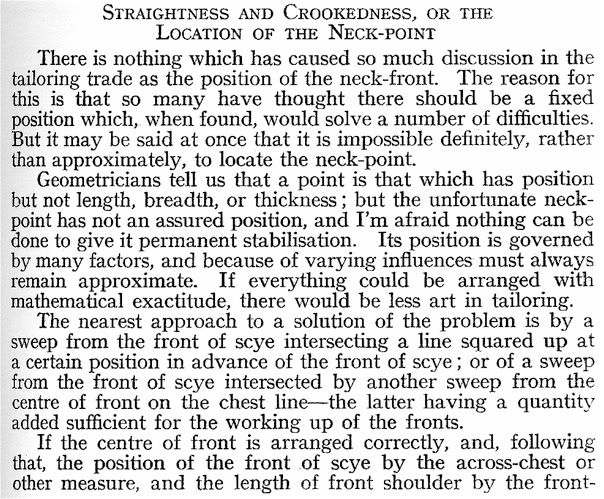
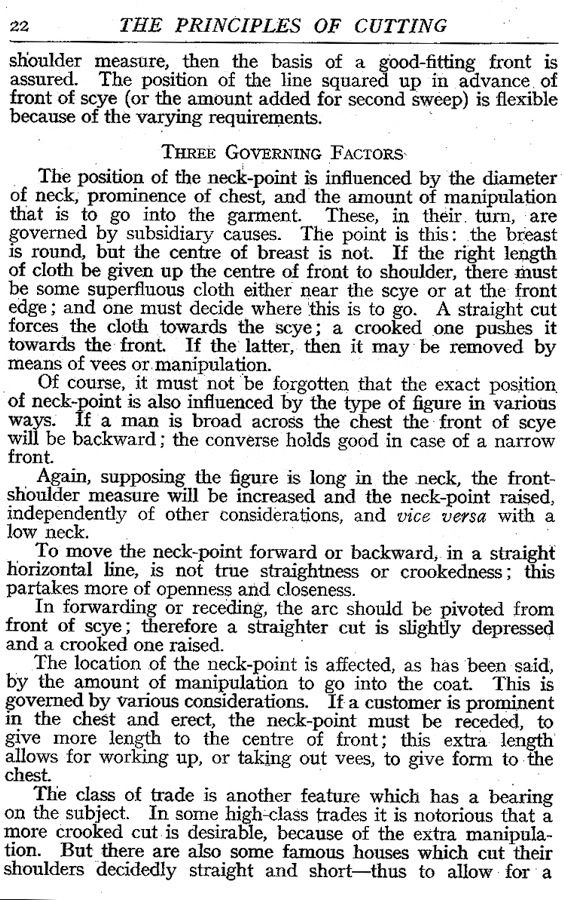
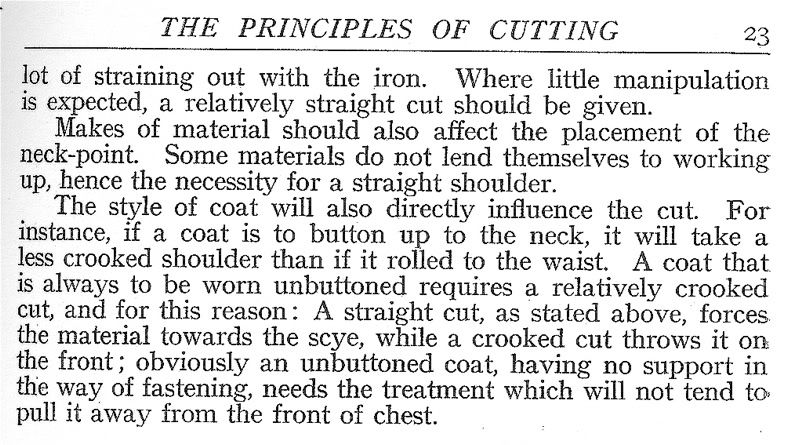
For a details on the source and bibliography see this thread:
http://thelondonlounge.net/gl/forum/vie ... php?t=8141
http://www.cutterandtailor.com/forum



For a details on the source and bibliography see this thread:
http://thelondonlounge.net/gl/forum/vie ... php?t=8141
http://www.cutterandtailor.com/forum
Last edited by Sator on Thu Nov 12, 2009 10:12 pm, edited 1 time in total.
-
Leonard Logsdail
- Posts: 180
- Joined: Sun Feb 20, 2005 1:56 am
- Location: New York
- Contact:
Well, this clears that problem up????!!!!
Leonard
Leonard
[quote="smoothjazzone"]This discussion seems way too complicated. The way I have always understood these concepts are as follows
My experience is that for ME (my shoulders are a lot more forward than most), a high armhole, a "crooked" shoulder, a shoulder seam thats further back and a tight collar allow for the greatest amount of movement while helping keep the garment comfortably on me at all times.
I would do the opposite on every point you have mentioned for your shoulder type.
One culprit in these situations is as Alden pointed out customers standing erect with their shoulders pulled back in some sort of military posture. Even the best of tailors will be tempted to cut a straigher coat than is necessary. Hence, the importance of assuming a very natural posture during fittings. Even a straight coat, depending on the fabric and the sewing adapt more (not perfectly) to your body over time. /quote]
I do not think of crooked or straight as a way to cut a jacket as much as a term used to define an adjustment I make on a jacket. I am currently constructing a jacket where the right shoulder is crooked and the left needs to be straightened for the fronts to look balanced. Many of the definitions and descriptions in this thread are different from my experiences.
My experience is that for ME (my shoulders are a lot more forward than most), a high armhole, a "crooked" shoulder, a shoulder seam thats further back and a tight collar allow for the greatest amount of movement while helping keep the garment comfortably on me at all times.
I would do the opposite on every point you have mentioned for your shoulder type.
One culprit in these situations is as Alden pointed out customers standing erect with their shoulders pulled back in some sort of military posture. Even the best of tailors will be tempted to cut a straigher coat than is necessary. Hence, the importance of assuming a very natural posture during fittings. Even a straight coat, depending on the fabric and the sewing adapt more (not perfectly) to your body over time. /quote]
I do not think of crooked or straight as a way to cut a jacket as much as a term used to define an adjustment I make on a jacket. I am currently constructing a jacket where the right shoulder is crooked and the left needs to be straightened for the fronts to look balanced. Many of the definitions and descriptions in this thread are different from my experiences.
-
storeynicholas
It's good to know some detail such as that in this thread but those of us who are not tailors are no more likely to use this information to start cutting our own coats than we are likely to start making our own computers - or indeed to start interfering in the making of coats or computers. However, accruing knowledge is always good and it doesn't really get better, for the subject, than in this place.
NJS
NJS
I posted this in the Bibliography for Cutters and Tailors:
http://thelondonlounge.net/gl/forum/vie ... 1&start=15
However, as it is highly relevant to the issue of balance and finding the right neck point, I will repeat it here. Here is how taking both a front and back scye depth measurement can be helpful to drafting a pattern with the correct balance.
Most tailoring manuals only discuss the most basic way to measure the arm scye depth - from behind. I will call this the back scye depth. This is the back scye depth (from a to b):

There is in fact another way of measuring the scye depth from the front. I will call this the front scye depth:
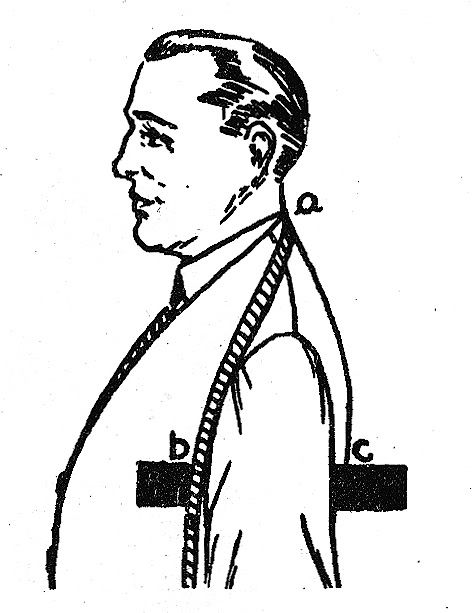
A ruler is placed horizontally under the armpit. To take the front scye depth, the tape measure begins at the top of the centre seam at the back (letter a) and goes down to the top edge of the ruler (letter b) as shown. The tape measure should be quite taut.
The reason for measuring both front and back scye depth is to get an idea of balance. On someone with a stooped posture (figure 18 below), the front scye depth is decreased and the back scye increased. The opposite occurs with an over erect stance (figure 19):
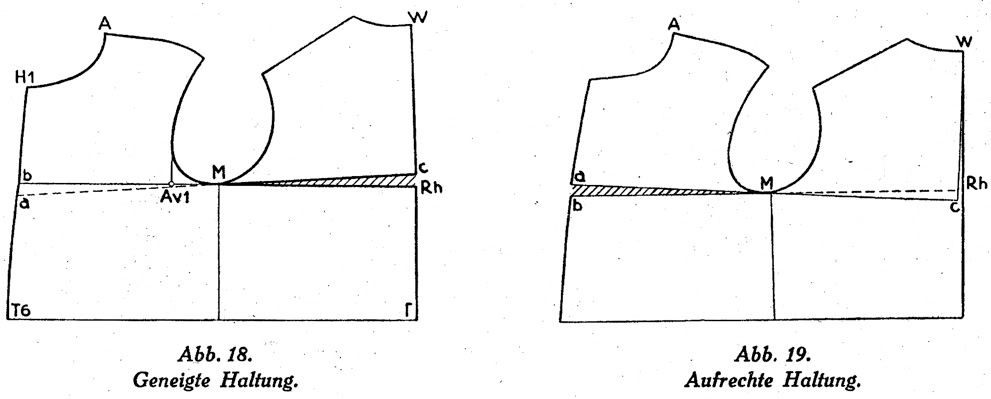
Here is how a pattern looks with front and back scye depths incorporated into it:
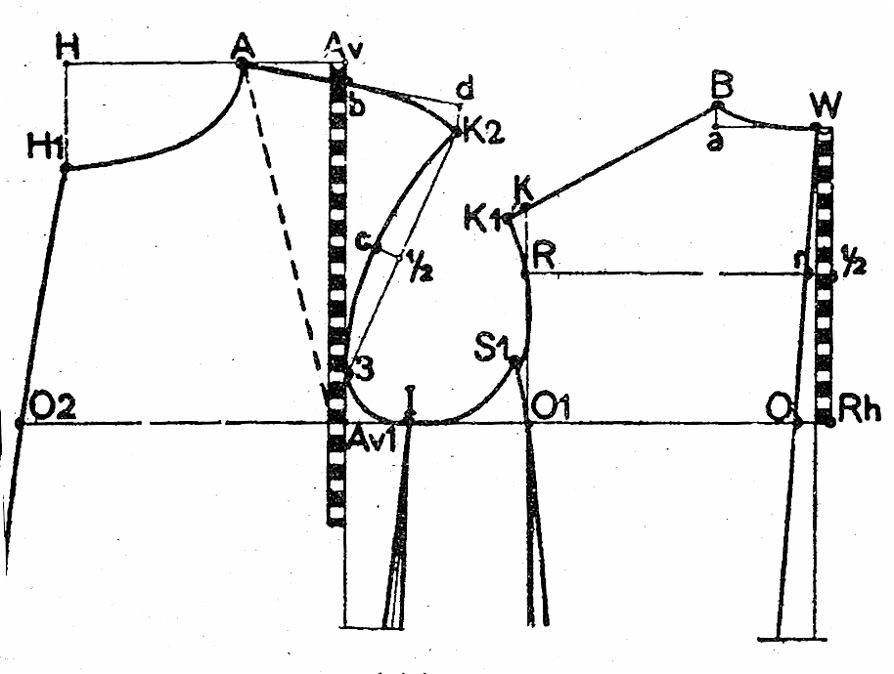
It certainly helps to guide the cutter to find the correct neck point to determine how straight or crooked the coat should be cut.
You can see that is very much similar to what SG has discussed previously but using the front and back scye depths to get an objective measure of front-back balance. This eliminates the need rely on just eye balling the figure to guess what the right balance should be, while allowing you to double check on the correct arm scye depth.
http://thelondonlounge.net/gl/forum/vie ... 1&start=15
However, as it is highly relevant to the issue of balance and finding the right neck point, I will repeat it here. Here is how taking both a front and back scye depth measurement can be helpful to drafting a pattern with the correct balance.
Most tailoring manuals only discuss the most basic way to measure the arm scye depth - from behind. I will call this the back scye depth. This is the back scye depth (from a to b):

There is in fact another way of measuring the scye depth from the front. I will call this the front scye depth:

A ruler is placed horizontally under the armpit. To take the front scye depth, the tape measure begins at the top of the centre seam at the back (letter a) and goes down to the top edge of the ruler (letter b) as shown. The tape measure should be quite taut.
The reason for measuring both front and back scye depth is to get an idea of balance. On someone with a stooped posture (figure 18 below), the front scye depth is decreased and the back scye increased. The opposite occurs with an over erect stance (figure 19):

Here is how a pattern looks with front and back scye depths incorporated into it:

It certainly helps to guide the cutter to find the correct neck point to determine how straight or crooked the coat should be cut.
You can see that is very much similar to what SG has discussed previously but using the front and back scye depths to get an objective measure of front-back balance. This eliminates the need rely on just eye balling the figure to guess what the right balance should be, while allowing you to double check on the correct arm scye depth.
-
Greger
One old tailor says that if the roll line stick out the coat is too crooked. It maybe tight at the scye.
And then there is the other way tight at the chest and loose at the scye.
And then there is the other way tight at the chest and loose at the scye.
-
- Information
-
Who is online
Users browsing this forum: No registered users and 41 guests

